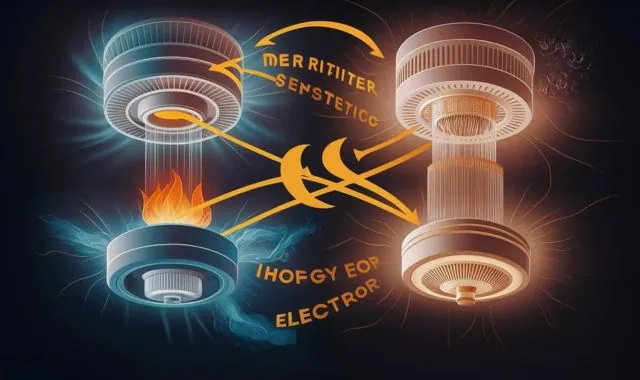Physical Address
304 North Cardinal St.
Dorchester Center, MA 02124

Smoke detectors save lives by giving you time to escape a fire. Understand the two main types, ionization (faster for flaming fires) and photoelectric (better for smoldering fires). Choose the right one for your needs and double up for maximum protection. Regularly test, clean, and replace your smoke detectors for peace of mind.

Imagine waking up to a faint smell of something burning, your heart pounding as you search for the source. But what if the fire isn’t raging yet, just smoldering silently? That’s where smoke detection comes in – your silent guardian against unseen threats.
Fires can start subtly, and early detection is crucial. Smoke detectors are your first line of defense, giving you precious time to escape a fire before it engulfs your home. But smoke detection goes beyond just fire. There’s another silent threat to be aware of:
Carbon monoxide (CO) is an odorless, colorless gas produced by incomplete combustion. It can leak from faulty furnaces, water heaters, or even fireplaces. CO inhalation can be deadly, so having working smoke detectors with CO alarms is an essential safety measure.
There are two main types of smoke detection technologies, each with its own strengths and weaknesses:
Imagine a tiny spotlight inside your smoke detector. Photoelectric alarms use a light source and a light sensor positioned at different angles within a chamber. When smoke enters, it scatters the light, triggering the alarm.
Photoelectric alarms excel at detecting smoldering fires that produce large smoke particles, giving you a crucial head start in escaping.
Cooking smoke is less likely to trigger a photoelectric alarm compared to ionization alarms.
Photoelectric alarms might take slightly longer to detect fast-burning fires with smaller smoke particles.
Ionization alarms use a small amount of radioactive material to ionize air molecules within a chamber. This creates a continuous electrical current. When smoke particles enter, they disrupt the flow of ions, triggering the alarm.

Ionization alarms are highly sensitive to small smoke particles, making them quicker to detect fast-burning fires.
Ionization alarms tend to be slightly cheaper than photoelectric alarms.
Cooking smoke or dust particles can sometimes trigger false alarms with ionization detectors.
Ionization alarms might not be as sensitive to the larger smoke particles produced by smoldering fires.
The best smoke detector for you depends on your home environment:
Opt for a photoelectric alarm to minimize nuisance alarms.
Install smoke detectors in every sleeping area and outside each bedroom door for maximum protection.
For the most comprehensive fire safety, consider using a combination smoke and CO detector. This provides protection against both fires and carbon monoxide poisoning.
Even the best smoke detectors need proper care:
Test your smoke detectors monthly by pressing the test button. Replace batteries annually or as recommended by the manufacturer.
Vacuum your smoke detectors gently with a soft brush to remove dust buildup that can hinder their performance.
Smoke detectors are a crucial first step, but don’t stop there:
Develop a fire escape plan for your family and practice it regularly. Identify multiple exits from each room and designate a meeting place outside your home.
Having a fire extinguisher readily available can help you control small fires before they escalate. However, remember that fire safety always prioritizes evacuation over fighting the fire yourself.

Smoke detectors are lifesavers, offering precious time to escape a fire before it engulfs your home. Now, armed with the knowledge of photoelectric and ionization technologies, you can choose the right detectors for your needs. Remember, the best approach is a layered one.
It’s crucial to test your smoke detectors regularly to ensure they’re functioning properly. Aim for monthly testing by pressing the designated test button on each detector.
Q: How often should I replace the batteries in my smoke detectors?
Replace the batteries in your smoke detectors annually, or even more frequently if the alarm chirps to indicate low battery. Consider using long-life lithium batteries for extended life between replacements.
Q: When should I replace my smoke detectors altogether?
Smoke detectors typically have a lifespan of 8-10 years. Replace your detectors after this timeframe, or even sooner if they malfunction or chirp even after new batteries are installed.
Q: Can I mix and match smoke detector types?
Absolutely! In fact, it’s recommended to have both photoelectric and ionization alarms in your home for the most comprehensive fire protection. Photoelectric alarms excel at detecting smoldering fires, while ionization alarms are faster to respond to flaming fires.
Q: What should I do if my smoke detector goes off?
If your smoke detector goes off, evacuate your home immediately following your fire escape plan. Do not waste time trying to find the source of the fire or gather belongings. Once outside, call the fire department from a safe distance.
Q: Are there any alternatives to traditional smoke detectors?
For those with hearing impairments, there are smoke detectors with flashing lights or vibrating pads to signal an alarm. Additionally, some smart home systems can integrate with smoke detectors, sending alerts to your phone or other devices in case of an emergency.